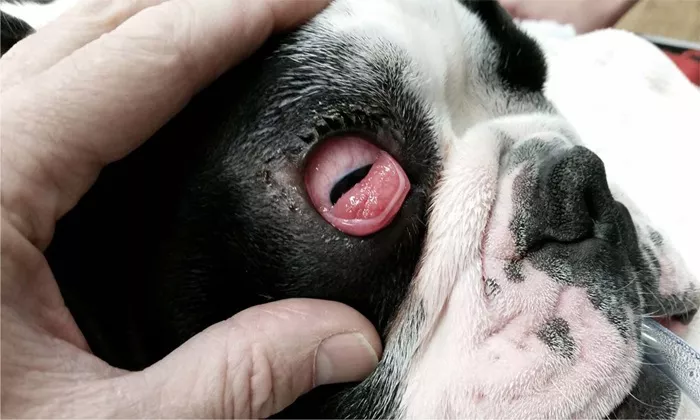Cherry eye is a condition that affects the eyes of some animals, especially dogs. It happens when a small gland in the corner of the eye slips out of its normal position. This gland is called the “third eyelid gland” or the “nictitans gland.”
This gland is important because it produces a large part of the tear film that keeps the eye moist and healthy. When it pops out, it looks like a red or pink lump in the corner of the eye. This is why it’s called “cherry eye.”
Why Cherry Eye Happens
The exact cause of cherry eye isn’t fully known. However, it is believed to be due to weak connective tissue holding the gland in place. Some dog breeds are more likely to get cherry eye, including:
- Bulldogs
- Beagles
- Cocker Spaniels
- Shih Tzus
- Lhasa Apsos
It can happen in one or both eyes and may show up suddenly. Cherry eye is not usually painful at first, but if left untreated, it can cause problems.
Symptoms of Cherry Eye
The most obvious sign of cherry eye is the red lump in the corner of the eye. Other signs include:
- Swelling around the eye
- Watery eyes
- Dry or irritated eyes
- Blinking more than usual
- Pawing at the eye
If the gland stays out for too long, it can get dry and inflamed. This can lead to infections or other serious eye problems.
How Cherry Eye Is Diagnosed
A vet can usually diagnose cherry eye just by looking at the eye. No special tests are usually needed. In some cases, the vet may check for signs of infection or dry eye.
It’s important to treat cherry eye early. Leaving it untreated can damage the gland and cause long-term issues with tear production. This may lead to chronic dry eye, which is painful and hard to manage.
What Is Cherry Eye Surgery?
Cherry eye surgery is a procedure to fix the problem by putting the gland back in its normal place. The goal is to keep the gland working properly so it can still make tears.
There are two main types of surgery:
1. Gland Replacement
This is the most common method. The surgeon repositions the gland and stitches it back into place. This way, the gland can still make tears and protect the eye.
2. Gland Removal
In rare cases, if the gland is badly damaged or keeps popping out even after surgery, the vet may remove it. But this is usually a last resort because removing the gland can lead to dry eye.
Before the Surgery
Before surgery, the vet will check the overall health of the pet. This may include blood tests and a full physical exam. The vet may also give eye drops to reduce swelling and prevent infection.
You may be asked to withhold food and water for a few hours before surgery. This helps reduce the risk of vomiting while under anesthesia.
During the Surgery
The pet is put under general anesthesia so they don’t feel any pain. The vet gently moves the gland back into its correct position and stitches it in place.
The surgery usually takes less than an hour. Most pets go home the same day.
After the Surgery
Recovery from cherry eye surgery is usually quick. Here’s what to expect:
- The pet may need to wear an Elizabethan collar (cone) to keep them from rubbing their eyes.
- The vet will give eye drops or ointments to reduce swelling and prevent infection.
- Pain relief may also be given.
- Follow-up visits are needed to check healing.
Most pets heal within a couple of weeks. It’s important to follow all aftercare instructions carefully to prevent complications.
Risks and Complications
As with any surgery, there are some risks. These may include:
- Infection
- Swelling
- The gland popping out again
- Reaction to anesthesia
If the gland pops out again, a second surgery may be needed. In some cases, more than one surgery is required to fully fix the problem.
Cost of Cherry Eye Surgery
The cost can vary depending on location, the type of surgery, and the vet’s experience. On average, cherry eye surgery can cost between $300 and $1,000 per eye.
Additional costs may include:
- Pre-surgery exams
- Blood tests
- Medications
- Follow-up visits
Pet insurance may cover some of the costs, depending on the plan.
Can Cherry Eye Be Prevented?
There’s no guaranteed way to prevent cherry eye, especially in breeds that are more likely to get it. However, regular eye check-ups and early treatment can help reduce the risk of serious problems.
If you notice any signs of cherry eye, take your pet to the vet as soon as possible. Early surgery offers the best chance for a full recovery.
Final Thoughts
Cherry eye may look scary, but it’s a treatable condition. With quick action and the right care, most pets recover well and continue to live happy, healthy lives. If your pet has cherry eye, talk to your vet about the best treatment options, including surgery. The sooner you act, the better the outcome for your pet’s eye health.
Related topics:
What Is Z-LASIK Eye Surgery? A Clear Guide
What Is Zyoptix Eye Surgery? A Detailed Guide
What Is ICL Eye Surgery? A Safe Vision Correction Option


